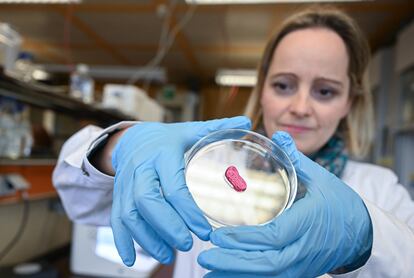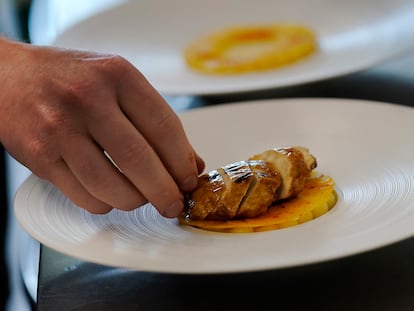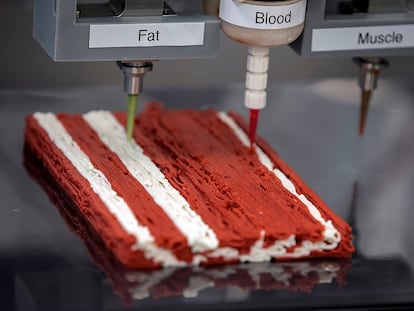Will macro-farms suffer the same fate as tobacco companies?
While the USDA just approved two companies that produce lab-grown meat, Italy, as a precaution, banned its production and sale

When the World Health Organization declared red and processed meat carcinogenic in 2015, it caused a stir. Would the butchers and delicatessens close? What about the steakhouses? Would there be no more barbecues? And what would happen to all the farms? Many people are convinced that an alternative to traditional meat must be found, but there is a challenging road ahead. How to replace it?
Cultured meat is emerging as one of the possible solutions, especially since June 21, when the U.S. Department of Agriculture officially approved the sale of the products of two companies, Good Meat and Upside Foods. Scientists have been experimenting for a decade with what is also known as in vitro meat, which is created from stem cells taken from the muscles of living animals. It differs from plant-based meat in that it contains the same animal fats and proteins as traditional meat, and it has a very similar texture, flavor and color. It is “real meat, made without the animal,” explained Upside Foods founder and CEO Uma Valeti. Consuming it does not raise the usual ethical questions linked to animal suffering, as it is made in a laboratory and represents a solution to future problems of food shortages. With it comes a potential food revolution.
Francesco Branca, the director of the WHO’s Department of Nutrition and Food Safety, notes via email that “cell-based foods could become a solution to address food shortages in the future.”
David Hunt, PhD in biotechnology and part of the Good Food Institute (GFI), an international non-profit organization that advocates for lab-grown meat as an alternative to traditional meat, says that “demand for meat is expected to increase by 52% globally by 2050. We don’t have enough land to meet that demand with conventional animal agriculture.”
One of the most relevant arguments in defense of this type of meat is that its production, (known as labriculture) will also minimize the environmental impact. A study by the Journal of Life Cycle Assessment, with data on the manufacturing processes of more than 15 companies, concluded that large-scale cultured meat production using renewable energy, could reduce the carbon footprint by 92%, land use by 90% and water use by 66%, compared to conventional meat production.
Cultured meat could also supposedly be healthier than regular meat, according to its advocates, as it requires no antibiotics and is not linked to infections caused by pathogens such as E. coli and Listeria. David Welch, PhD in biology, also from the GFI, the organization that defends this industry, says that it will be possible to “improve the nutritional profile of lab-grown meat by reducing the saturated fat content and optimizing amino acids and micronutrients.”
However, it is a new product, and some doubt its safety. In Italy, a bill was approved to prohibit its production and sale. This is a precautionary principle, as the possible harmful effects of ingesting a product based on pluripotent stem cells with tumor-inducing capabilities are still unknown. How will it affect the body in the medium and long term? What are the protocols to prevent and act in case of contamination? Independent researcher Derrick Risner, specializing in food science and technology, prefers to be cautious. “I would have to see evidence that lab-grown meat is healthier than traditional meat to make scientifically-based comments,” he states via email.
On the other end of the spectrum, Luis Fernando Otón Sánchez, an oncologist at the University of La Laguna, in Spain, does not see any reasons why lab-grown meat could be harmful. “On the contrary, it can guarantee the absence of certain pathogens or antibiotics that are common in meat produced on farms or in less regulated environments.” And he concludes: “In the U.S. and in Europe we have robust control and regulation mechanisms, with real experts who devote their lives to this. When the FDA says that something can be sold, I tend to trust it.”
So far, the only restaurant where lab-grown meat could be tasted was Huber’s Butchery and Bistro, in Singapore, which in 2020 approved the marketing of synthetic chicken made by Eat Just’s Good Meat. However, after the historic USDA approval, it can begin to be consumed in American restaurants. Chef José Andrés has signed an agreement with Good Meat to bring cultured meat to one of his restaurants in Washington, and Dominique Crenn, the only woman with three Michelin stars in the U.S., signed an agreement with Upside Foods to offer it on her menu. For Crenn, who had removed animal meat from her restaurants as part of her opposition to factory farming, this type of meat helps start a conversation about the future of food.
According to a recent study by Research and Markets (the world’s largest market research company), it is estimated that, by 2040, 60% of all the world’s meat will be created from cells grown in bioreactors. However, the 156 companies that according to the GFI are already working on its production have to make it truly sustainable and lower the cost of production so that the product can have a cost comparable to that of biological food.
In a first joint report, the of the UN and the WHO explain how the hazards identified at each stage of the cell-based food production process can be addressed, concluding that “the way forward will consist of continuing to invest in research and development in order to understand whether the alleged benefits in increased sustainability can be realized.”
If traditional meat can be replaced with a sustainable, affordable and healthier one, the meat industry would suffer the same fate as the tobacco industry. Not only would it no longer be necessary; it would be irresponsible and dangerous.
Sign up for our weekly newsletter to get more English-language news coverage from EL PAÍS USA Edition
Tu suscripción se está usando en otro dispositivo
¿Quieres añadir otro usuario a tu suscripción?
Si continúas leyendo en este dispositivo, no se podrá leer en el otro.
FlechaTu suscripción se está usando en otro dispositivo y solo puedes acceder a EL PAÍS desde un dispositivo a la vez.
Si quieres compartir tu cuenta, cambia tu suscripción a la modalidad Premium, así podrás añadir otro usuario. Cada uno accederá con su propia cuenta de email, lo que os permitirá personalizar vuestra experiencia en EL PAÍS.
¿Tienes una suscripción de empresa? Accede aquí para contratar más cuentas.
En el caso de no saber quién está usando tu cuenta, te recomendamos cambiar tu contraseña aquí.
Si decides continuar compartiendo tu cuenta, este mensaje se mostrará en tu dispositivo y en el de la otra persona que está usando tu cuenta de forma indefinida, afectando a tu experiencia de lectura. Puedes consultar aquí los términos y condiciones de la suscripción digital.
More information
Archived In
Últimas noticias
Venezuela hardens its ‘revolutionary state’ project amid pressure from Trump
Sydney Sweeney, the actress praised by Trump: ‘Women are up against what society wants them to be’
The Bolsonaro surname: An advantage or liability in Brazil’s 2026 presidential elections?
Raúl Rocha, from jet-setting with Miss Universe to arms trafficking and fuel theft
Most viewed
- Reinhard Genzel, Nobel laureate in physics: ‘One-minute videos will never give you the truth’
- Pablo Escobar’s hippos: A serious environmental problem, 40 years on
- Charles Dubouloz, mountaineering star, retires at 36 with a farewell tour inspired by Walter Bonatti
- Why we lost the habit of sleeping in two segments and how that changed our sense of time
- The fall of a prolific science journal exposes the billion-dollar profits of scientific publishing











































